 Post an Event
Post an Event
| Benton County Republicans’ Private Fundraising Event, “Bent-on Boots and Bling” with Trey Taylor |
| Friday, September 5, 2025 at 5:00 pm |
| Featuring Trey Taylor
Music Private Event
Friday, September 5, 2025 5:00-5:30 pm VIP Reception
5:30-8:00 pm Heavy Appetizers,
Auction, Concert
Red: $750 VIP Reception
Front Row Table Sponsor
White: $500 Table Sponsor
Blue: $50 per person
Limited Seating. Get Yours Now!!!
Support Local
Dress up: Bling, Cowboy, Patriotic Benton County Republican
FUNDRAISER
www.BentonGOP.org
Get your tickets today at:
https://www.bentongop.org/event-details/benton-county-republicans-fundraiser/form
About Trey:
Trey is the youngest African American Man in Country Music History. The Denver Post wrote
"It's impossible to miss his enthusiasm. With a fondness for cowboy boots, gaudy colors and dazzling jewelry, Trey Taylor could stand toe to toe with any of the Pop, Country or even Rap
contemporaries of his generation.“ |
| Trysting Tree Golf Club, 34028 NE Electric Rd., Corvallis |
How the government response to COVID-19 impacts people
At a recent press conference, Governor Kate Brown featured a victim of COVID-19, the disease. She has been less-than-supportive of those victims of COVID-19, the economic lockdown.
Walnut City Lanes, bowling and entertainment center in McMinnville, has been owned and operated by Jerry and Sharri Rettke for 43 years. During that time they have seen multiple economic cycles but with hard work and a faithful customer base they have survived and thrived as a business member of the community.
The COVID-19 shutdown first ordered in March of 2020 hit the heart of their strong bowling league season which is typically from November to May. Their business was deemed non-essential just as the planned spring break league play and corporate events were to have happened. Their 13 employees had to be let go. The Rettkes paid 4 weeks severance to the full-time staff, many of which had become like family.
Throughout the summer, with local restaurants open and adverse health statistics controlled their business, was forced limit activity before being shut down totally just as league season began. The hope for a return to opening in the fall coincided with the hope for a return to classrooms for school children. Neither happened, even though only one in ten thousand county residents had been listed as a COVID-19 death at that time. As the Rettkes face ongoing fixed expenses such as $38,000 in property taxes plus insurance and utilities -- all of which are at a higher rate than the previous year -- they must hang on by spending their retirement savings.
Their attractive location on Highway 99W would go quickly at auction if it comes to that, but at what discount? And what of their employees need for income? And what of their faithful customers need for a respite from social isolation?
--Tom Hammer| Post Date: 2021-01-04 09:51:06 | Last Update: 2021-01-04 11:10:26 |
Riders pay less than half the cost of the ride. Some pay none.
As part of the growing trend of law enforcement reform, manifesting itself in -- let's be frank -- reductions in penalties for crimes and illegal actions, in 2017 TriMet asked the Oregon Legislature for a bill so that they could do their own enforcement on fare evasion.
HB 2777 was passed authorizing mass transit districts to establish an administrative process to adjudicate ordinance violations. Oregon’s ACLU supported passage to increase access to TriMet passes for low-income individuals, seniors and people with disabilities, which they believed would reduce fare evasion.
In May of 2017, TriMet added 20 security personnel to respond to a knife attack that left two men dead and another injured. Drivers were told to let fare evaders on and push the “fare evasion†button. Drivers still feel they lack support and policies put them in danger by requiring them to tell confrontational fare evaders they didn’t pay enough.
On October 22, 2019 TriMet announced there were increasing fare inspectors to reduce the 14.5% found by a PSU study that ride without paying. The first month a homeless man
was charged $175 fare violation even though he had a transit pass. TriMet
discontinued an ad campaign in November that framed fare enforcement as a service to riders, after it generated substantial backlash.
Under Oregon law, a rider who fails to pay the transit fare or commits another transit-related violation can be cited in court and fined.
HB 2777 gives mass transit districts the ability to create an alternative administrative process for resolving violations including reducing fines through an in-house hearing or order community service before taking the case to court.
When Governor Brown announced the stay-at-home order in March of 2020, people began working from home and
ridership dropped 60%. Ridership has continued to stay at the 60% below 2019 levels. TriMet suspended cash fares for Hop Fastpass on March 26, 2020. This was done in response to COVID-19 to limit contact with boarders. Now that TriMet has a number of safety measures in place, and
faces a lawsuit for violating state law by not involving the public in that decision, they are again accepting cash as of October 1.
A D V E R T I S E M E N T

A D V E R T I S E M E N T
During the pandemic TriMet fare enforcers issued fewer citations for fare evasion. It follows that reduced ridership would reduce fare evasion. However, TriMet board changed the approach of the fare enforcers to “fare informing, not fare enforcing.†Enforcement practices are still in place, but they offer more leeway to some riders using more of an education process. Part of that education process is making riders aware of the
Transit Fare Programs that offers reduced fares for low-income riders, fare assistance, fare relief and a high school pass program.
TriMet received life support from a $185 million federal COVID-19 relief package, but are restricted on how it is used.
The 2021 budget includes funds for hiring eight new security workers to perform fare checks. Until the pandemic lockdown is terminated, the determination of whether
HB 2777 is beneficial remains in suspense.
--Donna Bleiler| Post Date: 2021-01-04 01:48:59 | Last Update: 2021-01-04 09:51:06 |
Their track record doesn’t justify the title
How closely Governor Brown follows New York will play out in our legislative session. Governor Cuomo leads the way for Democrat governors. It doesn’t seem to matter that it is unconstitutional.
The New York State Senate just dropped the next bombshell by introducing Assembly Bill A416, relating to the removal of cases, contacts and carriers of communicable diseases who are potentially dangerous to the public health. The bill reads,
“the commissioner or the heads of local health departments, may order the removal and/or detention of such a person or of a group of such persons by issuing a single order, identifying such persons either by name or by a reasonably specific description of the individuals or group being detain. Such person or group of persons shall be detained in a medical facility or other appropriate facility or premises designated by the governor of his or her delegee and complying with subdivision five of this section.â€
The bill isn’t limited to COVID-19. Any disease carrier the Governor considers dangerous to public health will instantly subject a person to total submission to the state. They take complete control of your body and can vaccinate and experiment on you all they want without your permission. You will be a prisoner of the state.
They can’t let the coronavirus pass without another plan to keep control of people. The Oregon Health Authority just released and error notification saying:
If you are one of the Oregonians who received a notification on your cell phone about COVID exposure tracking, please know that the Oregon Exposure Notification Application, also known as OR Notify, was released earlier than anticipated. Apple inadvertently turned the application on and has since turned it off.
The project is still under development. Oregon Health Authority partnered with Oregon State University, which led a pilot of the application that ended Thursday. OHA will assess the results to determine when to launch the application.
People are rarely without their cell phones, so hopefully, installation of the software will be voluntary.
--Donna Bleiler| Post Date: 2021-01-03 20:45:00 | Last Update: 2021-01-04 01:48:59 |
Trophy list shows exercise of her will
In a move that can only be interpreted as a strong-arm warning to other businesses, the Oregon Occupational Safety and Health Administration has released a list of COVID-19 related penalties issued to businesses. Though Oregon OSHA is tasked by the Legislature with ensuring employee safety in the workplace -- their
mission statement on their website describes it as "To advance and improve workplace safety and health for all workers in Oregon" -- under the direction of Oregon Governor Kate Brown, OSHA has been tasked with enforcing her questionably legal COVID-19 lockdown restrictions.
According to the
summary of citations, "Since March, Oregon OSHA has received about 18,400 complaints related to COVID-19. Since then, we have also received about 3,600 non-Covid complaints. For perspective, in a typical year we receive just over 2,000 complaints." They also claim that "Since March, Oregon OSHA has issued at least 70 citations to employers for violating requirements to protect workers from COVID-19. Penalties for non-willful violations ranged from $100 to $2,000, while penalties for willful violations ranged from $8,900 to $17,500."
As some cities and counties pledge support to businesses that try to open, and many local police and sheriffs are lukewarm or outright refusing to enforce the Governor's edicts, Brown has turned to the bureaucracy, namely Oregon OSHA and to a lesser degree the Oregon Liquor Control Commission to step outside their lane and enforce COVID-19 mandates. Some of the citations are explicitly directed toward customer behavior.
A D V E R T I S E M E N T
A D V E R T I S E M E N T
In the opinion of State Representative Mike Nearman (R-Independence), this represents a crisis in separation of powers. "With few exceptions, all of the Executive branch, which includes OSHA, gets their direction from the legislature. They have no such mandate."
Some activists will see the publication of this list as an opportunity to locate businesses to patronize, to support them as they stand against the Governor. In stark contrast to the March lockdowns, people and businesses are beginning to fight these mandates, oblivious to the penalties. Below are the penalized businesses, arranged by county:
Coos County
- Dalin LLP – North Bend – restaurant willfully failed to follow prohibition of on- premises consumption of food or drink.
- June 2020
- Total penalty: $8,900
Deschutes County
- Laui Life Coffee LLC (Kevista Coffee) – Bend – willfully failed to implement face coverings per sector-specific guidance for bars and restaurants.
- July 2020
- Total penalty: $8,900
Douglas County
- Mounts Enterprises (Casey’s Restaurant) – Roseburg – willfully failed to follow prohibition of on-premises consumption of food or drink; employer also cited for serious violation of Red Warning Notice.
- May 2020
- Total penalty: $13,900
Klamath County
- Annie J Patzke, Patricia A. Barney, Michael Patzke (Casey’s Restaurant) – Klamath Falls
– willfully allowed on-premises consumption of food and drink against restrictions, as outlined in Oregon OSHA’s temporary rule, potentially exposing employees to COVID- 19.
- December 2020
- Total penalty: $8,900
Lake County
- Howard’s Pharmacy – Lakeview – willfully failed to implement health hazard controls such as face coverings and physical distancing; employer also cited for serious violation of Red Warning Notice.
- September 2020
- Total penalty: $9,400
Marion County
- Glamour Salon – Salem – willfully failed to follow executive order prohibiting operation of barber shops and hair salons.
- May 2020
- Total penalty: $14,000
- Capitol Racquet Sports Inc. (one of four locations inspected and cited) – Salem – willfully continued to operate fitness center following executive order to close to the public; employer also cited for serious violation of Red Warning Notice.
- November 2020
- Total penalty: $22,500
- Capitol Racquet Sports Inc. (two of four locations inspected and cited) – Salem – willfully continued to operate fitness center following executive order to close to the public; employer also cited for serious violation of Red Warning Notice.
- November 2020
- Total penalty: $22,500
- Capitol Racquet Sports Inc. (three of four locations inspected and cited) – Salem – willfully continued to operate fitness center following executive order to close to the public; employer also cited for serious violation of Red Warning Notice.
- November 2020
- Total penalty: $22,500
- Capitol Racquet Sports Inc. (four of four locations inspected and cited) – Salem – willfully continued to operate fitness center following executive order to close to the public; employer also cited for serious violation of Red Warning Notice.
- November 2020
- Total penalty: $22,500
Polk County
- Café 22 West – Salem – willfully failed to implement health hazard controls – such as face coverings and physical distancing; employer also cited for serious violation of Red Warning Notice.
- September 2020
- Total penalty: $13,900
Clackamas County
- Cal Farms Inc. – Oregon City – did not follow the requirement of the temporary emergency rule in agriculture to provide field sanitation information for workers.
- July 2020
- Total penalty: $0 (other-than-serious)
- Siri and Son Farms Inc. – Clackamas – did not follow requirements of the temporary emergency rule in agriculture, including those related to maintenance and field sanitation notice.
- September 2020
- Total penalty: $240
- Space Age Fuel Inc. – Clackamas – failure to provide health hazard controls, including requiring customers to wear face coverings.
- October 2020
- Total penalty: $270
Clatsop County
- Bon Esprits Ltd – Seaside – liquor store did not ensure employees were wearing face coverings.
- August 2020
- Total penalty: $100
Deschutes County
- Fred Meyer Stores Inc. – Redmond – failure to protect employees from potential exposure to COVID-19, including not providing them – and ensuring they used – health hazard controls such as face coverings.
- September 2020
- Total penalty: $700
- Axis Salon LLC – Redmond – failure to implement health hazard controls, including ensuring employees and customers wear face coverings.
- September 2020
- Total penalty: $175
- Cascade Sundowners LLC – Terrebonne – failure to implement health hazard controls, including requiring customers to wear face coverings and ensuring employees engage in physical distancing (employer was also cited for violations unrelated to COVID-19).
- October 2020
- Total penalty: $480
- BoXiT Fitness Studios LLC – Bend – failure to implement health hazard controls, including ensuring staff and customers wore face coverings.
- September 2020
- Total penalty: $175
- T and M Bolken Enterprises LLC – Bend – did not post clear educational signs, as required, including information about face coverings, physical distancing, maximum occupancy, and COVID-19 symptoms.
- September 2020
- Total penalty: $0 (other-than-serious)
- Alfalfa Store Inc. – Bend – failure to provide health hazard control measures for employees, including ensuring customers and employees wore face coverings inside and outside the retail establishment; ensuring physical distancing; and posting COVID- 19 health information.
- October 2020
- Total penalty: $175
- Scott Wyke (Hammer Down Firearms) – Bend – failure to provide health hazard control measures, including ensuring customers and employees wore face coverings; implementing physical distancing; and posting health information.
- November 2020
- Total penalty: $175
Douglas County
- Mounts Enterprises (Casey’s Restaurant) – Roseburg – did not provide health hazard control measures, including ensuring employees – when preparing or cooking food and when seating or serving customers – wore face coverings; and ensuring customers do not sit at the counter when six feet of distance cannot be maintained between them and employees behind the counter.
- November 2020
- Total penalty: $280
Grant County
- Chester’s Market Inc. – John Day – failure to implement health hazard control measures to protect employees – working inside and outside the retail outlet – by ensuring customers wore face coverings and posting COVID-19 health information for customers and employees.
- October 2020
- Total penalty: $490
Jackson County
- Gold Standard Investment Group LLC – Central Point – did not follow requirements of the temporary emergency rule in agriculture, including adjacent toilet and handwashing facilities; sanitation schedule; and field sanitation information for workers.
- July 2020
- Total penalty: $200
- Kelli Bieber – Central Point – did not follow requirements of the temporary emergency rule in agriculture, including adjacent toilet and handwashing facilities; sanitation schedule; and field sanitation information for workers.
- July 2020
- Total penalty: $390
- Walker Lang & Associates LLC – Medford – failure to implement health hazard controls, including communicating and implementing a physical distancing policy.
- August 2020
- Total penalty: $120
- Rogue Valley Hemp LLC – Medford – did not follow requirements of the temporary emergency rule in agriculture, including those related to toilet and handwashing facilities, and maintenance.
- September 2020
- Total penalty: $200
- Humbug Hospitality LLC – Jacksonville – did not follow requirements of the temporary emergency rule in agriculture, including those related to toilet and handwashing facilities, maintenance, and drinking water.
- September 2020
- Total penalty: $300
- 5012 Colver Road LLC – Talent – did not follow requirements of the temporary emergency rule in agriculture, including those related to maintenance, physical distancing, toilet and handwashing facilities, and field sanitation notice.
- October 2020
- Total penalty: $300
- Pacific Crest Vineyard Services LLC – Medford – did not follow the requirement of the temporary emergency rule in agriculture to provide field sanitation information, including about the rule’s requirements and where workers may file complaints.
- October 2020
- Total penalty: $0 (other-than-serious)
- LP Farms LLC – Central Point – did not follow requirements of the temporary emergency rule in agriculture, including those related to toilet and handwashing facilities, and maintenance.
- October 2020
- Total penalty: $200
- NV Farms LLC – Central Point - did not follow the maintenance requirement of the temporary emergency rule in agriculture, mandating regular sanitation of toilet facilities to mitigate the potential spread of COVID-19.
- October 2020
- Total penalty: $100
- Grace Cascade Christian High School – Medford – operated in-person education against restrictions outlined by Oregon Department of Education and did not ensure all individuals wore face covering while in classrooms, as required by Oregon OSHA’s temporary rule.
- December 2020
- Total penalty: $360
Josephine County
- Masterbrand Cabinets – Grants Pass – forest products manufacturer did not provide health hazard controls, including physical distancing and face coverings.
- May 2020
- Total penalty: $630
- Dimmick Farms LLC – Merlin – did not follow requirements of the temporary emergency rule in agriculture, including those related to physical distancing officer, maintenance, and field sanitation notice.
- September 2020
- Total penalty: $600
Lake County
- JW Kerns Inc. – Christmas Valley – failure to provide health hazard control measures, including ensuring customers and employees wore face coverings while inside and outside the retail establishment; ensuring physical distancing; and posting COVID-19 health information.
- October 2020
- Total penalty: $150
Lane County
- Cabela’s Wholesale LLC – Springfield – did not provide health hazard controls such as physical distancing.
- June 2020
- Total penalty: $2,400
- I&N Inc. – Veneta – gas station and minimart did not use health hazard control measures such as physical distancing and face coverings.
- August 2020
- Total penalty: $600
- Lowe’s Home Centers LLC – Eugene – did not protect employees from potential exposure to COVID-19 by ensuring customers wore face coverings.
- November 2020
- Total penalty: $700
Lincoln County
- Muggly’s LLC – Toledo – bowling alley was open against requirements of Lincoln County’s Phase One status – related to protections against the potential spread of coronavirus – as part of Oregon’s re-opening process.
- October 2020
- Total penalty: $175
Linn County
- National Frozen Foods Corporation – Albany – did not provide health hazard controls such as physical distancing.
- May 2020
- Total penalty: $2,000
- Barenbrug USA Inc. – Tangent – did not provide health hazard controls such as physical distancing.
- July 2020
- Total penalty: $210
Malheur County
- Jimmy Simpson and Janice Simpson (Owyhee Grocery Store) – Nyssa – did not provide health hazard controls, including ensuring customers and employees wore face coverings indoors; limiting the number of customers indoors while focusing on physical distancing; and posting COVID-19 health information.
- October 2020
- Total penalty: $105
Marion County
- Silver Creek Auto Parts Inc. – Silverton – failure to implement health hazard controls for employees working inside and outside the retail store, including ensuring customers and employees wore face coverings and increasing physical distancing between employees, as well as between customers and employees.
- September 2020
- Total penalty: $280
- C & H Management Inc. – Stayton – hardware store did not provide health hazard controls to protect an estimated 15 employees, working inside and outside store, from COVID-19. Controls such as facial coverings for customers and employees, and physical distancing were not implemented.
- November 2020
- Total penalty: $280
Multnomah County
- Indian Ladle LLC – Portland – did not provide health hazard control measures to protect employees, including ensuring employees and customers wore face coverings, and posting health information about COVID-19.
- December 2020
- Total penalty: $100
- Dillon & Associates (NW Office Liquidations) – Portland – furniture store was not closed to the public per executive order.
- April 2020
- Total penalty: $175
- S&J Entertainment LLC – Portland – adult entertainment club was not closed to the public per executive order.
- May 2020
- Total penalty: $100
- City Liquidators Inc. – Portland – furniture store was not closed to the public per executive order.
- June 2020
- Total penalty: $280
- Etz Hayim Holdings SPC – Portland – failure to implement health hazard controls, such as physical distancing or face coverings (employer was cited for other violations unrelated to COVID-19).
- October 2020
- Total penalty: $1,050
- Riverview Restaurant LLC – Troutdale – failure to establish an effective safety committee or hold effective safety meetings that would enable employees to discuss health and safety issues related to COVID-19.
- September 2020
- Total penalty: $120
- The Farm on Sauvie Island LLC – Portland – did not follow the requirement of the temporary emergency rule in agriculture to provide field sanitation information for workers.
- September 2020
- Total penalty: $0 (other-than-serious)
- PetSmart Inc. – Portland – failed to protect employees from potential exposure to COVID-19 by ensuring customers wore face coverings.
- October 2020
- Total penalty: $700
Tillamook County
- Terry Phillips (Killer Coffee) – Tillamook – did not implement health hazard control measures including providing face coverings to employees and ensuring they wore them while they served the public and when six feet of distance could not be maintained between employees indoors.
- November 2020
- Total penalty: $280
Washington County
- Unger Farms Inc. – Cornelius – did not provide one handwashing facility per 10 employees per the temporary emergency rule in agriculture.
- July 2020
- Total penalty: $0 (other-than-serious)
- Unger Farms Inc. – Cornelius – did not follow requirements of the temporary emergency rule in agriculture, including those related to toilet and handwashing facilities; general physical distancing; drinking water; maintenance; and reasonable use of facilities.
- November 2020
- Total penalty: $800
- Old Trapper Smoked Products Inc. – Forest Grove – did not provide health hazard controls, including physical distancing; face coverings; or barriers.
- June 2020
- Total penalty: $700
- Oregon Berry Packing Inc. – Hillsboro – did not follow the requirement of the temporary emergency rule in agriculture to provide field sanitation information for workers.
- August 2020
- Total penalty: $0 (other-than-serious)
- West Union Gardens Inc. – Hillsboro – did not follow requirements of the temporary emergency rule in agriculture, including those related to drinking water; toilet and handwashing facilities; field sanitation notice; physical distancing officer; and disease prevention.
- August 2020
- Total penalty: $350
- Krueger’s Tree Farm Inc. – North Plains – did not follow requirements of the temporary emergency rule in agriculture, including those related to physical distancing officer and general physical distancing (employer was also cited for violations unrelated to COVID- 19).
- November 2020
- Total penalty: $100
- Mod Super Fast Pizza LLC – Sherwood – did not implement health hazard controls, including ensuring customers who were not eating or drinking wore face coverings.
- September 2020
- Total penalty: $300
- Gaston Nursery LLC – Gaston – did not follow requirements of the temporary emergency rule in agriculture, including those related to maintenance; disease prevention; toilet and handwashing facilities; physical distancing officer; and field sanitation notice.
- October 2020
- Total penalty: $360
- Gaston Nursery LLC – Hillsboro – failed to ensure toilet facilities were cleaned when necessary and sanitized at least three times daily to mitigate the spread of COVID-19.
- November 2020
- Total penalty: $180
Yamhill County
- J Bacon Farms LLC – McMinnville – did not follow the requirement of the temporary emergency rule in agriculture to provide field sanitation information for workers.
- October 2020
- Total penalty: $0 (other-than-serious)
- Jacinto Espinoza Labor LLC – McMinnville – did not follow the requirement of the temporary emergency rule in agriculture to provide field sanitation information for workers.
- September 2020
- Total penalty: $0 (other-than-serious)
--Staff Reports| Post Date: 2021-01-03 14:21:53 | Last Update: 2021-01-04 17:22:15 |
Asking for a friend. A very sick friend.
As the lockdowns and hand-wringing over COVID-19 continue, data from the 2020-21 flu season is starting to emerge as an "emperor has no clothes" moment, reminding us that data and science should still inform decision making.
This
chart from the CDC website which shows weekly percentage of hospital visits for influenza like illnesses from September to August, so as to capture a single flu season. As you can see, during most years, flu hospitalizations start to increase at about week 48, which is around the end of November, peaking somewhere about the end of January or early February.
There a few possible explanations:
- This is just an off year for the flu. For some reason, it's just not that bad.
- Flu cases are way down because of all the masking and social distancing that people have been doing.
- Incentives exist to record cases of the ordinary flu as COVID-19, so that's how they get recorded.
I could be any one of these, or a combination of these. The CDC offers a possible explanation
on its website:
"The U.S. Outpatient Influenza-like Illness Surveillance Network monitors outpatient visits for influenza-like illness, not laboratory-confirmed influenza, and as such, will capture visits due to other respiratory pathogens, such as SARS-CoV-2, that present with similar symptoms. In addition, healthcare-seeking behaviors have changed dramatically during the COVID-19 pandemic. Many people are accessing the healthcare system in alternative settings which may or may not be captured as a part of ILINet. Therefore, ILI data, including ILI activity levels, should be interpreted with extreme caution. It is particularly important at this time to evaluate syndromic surveillance data, including that from ILINet, in the context of other sources of surveillance data to obtain a complete and accurate picture of both influenza and COVID-19 activity."
In other words, if you think you're seeing something here, you might not really be seeing it, so move on. It's true that more people are using other ways to access the medical system, like tele-health, but there aren't many alternatives to hospitalization for extreme symptoms. In any case, if trends continue, this will have to be explained.
Government -- at least state government in Oregon -- keeps telling us what danger we are in. It's nice to see that at least one problem has apparently fixed itself.
A D V E R T I S E M E N T

A D V E R T I S E M E N T
--Staff Reports| Post Date: 2021-01-03 13:36:54 | Last Update: 2021-01-04 17:23:02 |
U.S. Marshals arrest escapee in Portland, Oregon
David Dahlen had recently escaped custody from the Portland Police Bureau on Saturday, January 2, 2021, partially due to mandated coronavirus holding cell cleaning procedures.
In the morning hours of Friday, January 8, 2021, the United States Marshal's Fugitive Task Force located attempted murder suspect and escapee David Dahlen, 24, inside a vehicle at Lents Park, 4808 Southeast 92nd Avenue. They notified the Portland Police Bureau and members of the Homicide Unit, Tactical Operations Division, K9 Unit, and East Precinct patrol responded to assist.
At about 8:50a.m., the U.S. Marshals attempted to block the vehicle Dahlen was in, however, the driver of the vehicle was able to escape the Marshals' efforts. The vehicle fled from the area, heading eastbound on Southeast Holgate Boulevard. Officers assigned to East Precinct set up spike strips near the 11000 block of Southeast Holgate Boulevard, which the vehicle occupied by Dahlen ran over. The vehicle's tires deflated, the driver attempted to swerve around another vehicle, lost control, and crashed into a retaining wall and a power pole near the 11400 block of Southeast Holgate Street. The impact damaged the pole and knocked wires onto the street. Dahlen fled from the crashed vehicle and an East Precinct officer took him into custody a short distance away. Another person in the car was also detained.
Dahlen was transported to an area hospital where he will be checked for injuries due to the crash. The other occupant of the vehicle will also be seen at an area hospital for injuries. His identity will be released if he is charged with a crime.
"It's clear that this individual has no regard for the safety of the public and will put others in danger in an effort to escape," said Chief Chuck Lovell. "I'm grateful to the United States Marshals Fugitive Task Force, the PPB Homicide Unit, the Tactical Operations Division, East Precinct patrol officers, and all who worked together to capture this dangerous fugitive. "
--Ben Fisher| Post Date: 2021-01-03 11:00:56 | Last Update: 2021-01-08 19:10:46 |
The ridership crunch is softened by your tax dollars
Everyone knows that businesses have been taking a big hit from COVID-19. What is not so apparent is that transit is also taking a hit and this might cause long-lasting impacts for these districts.
Boardings -- defined as getting on a transit vehicle, even if this is part of a longer ride -- are down. Way down. What is not shown in this chart is the WES boardings, which had a similar fall from a high of 7,500 in October 2019 to a low in April 2020 of 1,250.
Tri-Met is the largest transit district, serving the greater Portland area. It's heavily subsidized -- over 75% of its revenue comes from taxes, not from fares -- so, the loss in ridership won't have as big an impact on its ability to stay afloat, but its revenue source is payroll taxes, and as unemployment is high, these taxes take a hit. As paid boardings decline and fewer fare dollars are collected per transit mile, the operating cost per boarding goes up. In other words, it costs a certain amount to get a bus or MAX train to go a mile and if you get more people on, the cost per person per mile goes down. In April, 2020 the operating cost per boarding shot up to over $15.00.
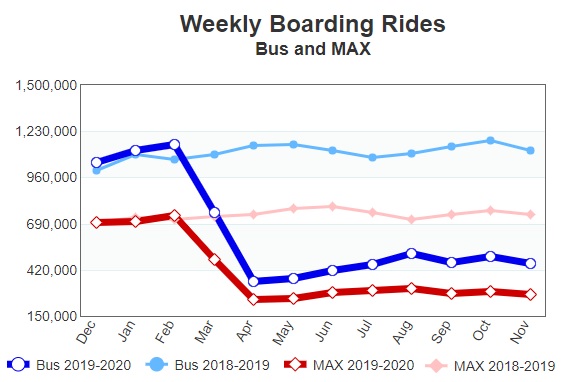
The future of transit may be waning, at least in the Portland area. Voters rejected a
transit tax in the 2020 election, signaling that after several months of COVID-19, they were not in the mood for more taxes and more transit. One would think that the part of loss of ridership that is due to people being unemployed would easily come back once the jobs come back. The part of ridership loss due to fear of COVID-19 might be harder to recover.
Tri-Met's website says that they are working hard to keep transit areas
clean and free of COVID-19, but it may not be enough to raise the confidence level of many people.

And let's not forget that crime is a big factor in deterring ridership, and Portland had a long, hard summer of crime. It seems like de-criminalizing everything is the rage these days.
HB 4907 prohibiting police officer from conducting or participating in activities intended to determine whether person has paid certain user charges, fees or tolls imposed by mass transit district passed the House but never made it to the Senate in the walkout-shortened 2020 session.
--Staff Reports| Post Date: 2021-01-03 09:43:40 | Last Update: 2021-01-03 11:11:04 |
Democrats will have to do a balancing act
According to the US Constitution, a census shall be taken every ten years. This is described in Article I, Section 2.
The actual Enumeration shall be made within three Years after the first Meeting of the Congress of the United States, and within every subsequent Term of ten Years, in such Manner as they shall by Law direct. The Number of Representatives shall not exceed one for every thirty Thousand, but each State shall have at Least one Representative.
Once this is done -- and it should be done in the spring of this year -- the Oregon Legislature is set with the task of redrawing all the State House, State Senate and US Representative Congressional districts. What makes the process more fun this year is that Oregon is all but certain to get a 6th Congressional District. We currently have five.
Article IV, Section 6 of the Oregon Constitution contains more specific instructions on redistricting, or as it's called, apportionment.
Apportionment of Senators and Representatives; operative date. (1) At the odd-numbered year regular session of the Legislative Assembly next following an enumeration of the inhabitants by the United States Government, the number of Senators and Representatives shall be fixed by law and apportioned among legislative districts according to population. A senatorial district shall consist of two representative districts. Any Senator whose term continues through the next odd-numbered year regular legislative session after the operative date of the reapportionment shall be specifically assigned to a senatorial district. The ratio of Senators and Representatives, respectively, to population shall be determined by dividing the total population of the state by the number of Senators and by the number of Representatives. A reapportionment by the Legislative Assembly becomes operative as described in subsection (6) of this section.
Democrats are in charge of the Legislature and barring some kind of internal division, they will draw a map that favors their fortunes. Elections have consequences. That's how it's done. The Legislature just draws a map and passes it as a bill. If they fail to do so, the job goes to the Secretary of State, and inevitably, there will be some lawsuits that get heard in the Oregon Supreme Court, but when the dust settles, we'll have new districts that reflect changes in population.
A D V E R T I S E M E N T

A D V E R T I S E M E N T
Speculation runs wild about what the Congressional map of Oregon will look like. To many, it seems like Central Oregon should get a district. Bend is the fastest growing city in the state, with no end in sight. Some think that the coast, long divided as appendages into three different Congressional Districts should be one district. After all, people in Astoria tend to be like those in Newport as well as Coos Bay.
Democrats will have to decide if they are willing to weaken the 4th and 5th Congressional Districts, currently held by Peter DeFazio and Kurt Schrader, respectively. The voter registration is close in both districts.
No matter how you slice it, the result of redistricting will create as much opportunity as it creates controversy.
--Staff Reports| Post Date: 2021-01-02 20:53:06 | Last Update: 2021-01-02 21:22:03 |
Quite a few were out-of-towners
New Years' Day featured two events near the State Capitol in Salem. The event at the Oregon State Capitol was organized by Oregon Women for Trump and was heavily attended by affiliates of the Proud Boys. Many of the attendees at the state capitol were armed with various weapons, knives, chemical sprays, batons and firearms. The event at Bush’s Pasture Park was organized by self-identifed anti-fascists who were also armed with a variety of weapons including firearms.
The Salem Police Department, along with the Oregon State Police and the Marion County Sheriff’s Office, worked cooperatively to provide an enhanced presence in and around where the protests were to be held with the goal of ensuring those who gathered were there to do so peacefully. With the potential for these events to be disruptive to nearby neighborhoods and interfere with vehicular traffic, an educational campaign to alert neighborhoods and motorists to the event was proactively released. In addition, officers contacted or attempted to contact the organizers of both events to educate them on our objectives for a safe and successful event, as well as provide information on what actions could result in law enforcement action.
At approximately 2:00 p.m. the protestors at the state capitol began an un-permitted march to Mahonia Hall on Lincoln St. SE. As the march proceeded, many people walked in the street and blocked intersections at which point they were advised their actions could have enforcement consequences. Protestors arrived at Mahonia Hall where a contingency of Oregon State Police troopers and Salem Police officers remained present. At the conclusion of their protest, the group began marching back to the state capitol. A small group of Proud Boys broke off from the main march toward Bush’s Pasture Park where a small group of anti-fascist protesters were still gathered. Salem Police quickly moved officers and equipment into the park to keep the two rival groups from converging and prevented a potentially violent encounter.
At approximately 4:00 p.m., Proud Boys and associates returning to the state capitol approached a group of individuals who were armed with bats, paintball guns and firearms standing in front of a building near High and State Streets. A heated verbal exchange ensued between the two groups. With the goal of keeping opposing groups apart, crowd management officers quickly responded to quell the dispute and keep the groups separated. Neither group complied with initial dispersal orders and Proud Boys affiliates had to be forcibly moved back from the business by officers. Officers also had to move the business group back towards the business to keep them from repeatedly interfering with enforcement actions on State St.
Once enough law enforcement resources were in position to safely deal with the groups, the growing crowd was informed via loudspeaker the gathering was an unlawful assembly. The declaration was given because the crowd no longer appeared to be protesting but was instead attempting to instigate fighting and tumultuous behavior. When officers attempted to push the crowd back, they were met with physical resistance and smoke grenades.
A D V E R T I S E M E N T

A D V E R T I S E M E N T
It took approximately one hour, most of the officers assigned to the event and the utilization of physical force and less-than-lethal munitions to move the crowd out of the streets and back to the state capitol. Three people were taken into custody for their actions during the declared unlawful assembly.
The objectives set for the day were the protection of life, protection of property, keeping opposition groups apart to prevent conflict, enforcement of crimes including minor infractions when appropriate and reasonable, and conducting follow up investigation of crimes which could not be dealt with immediately. There were no reported injuries, loss of life, or damage to property during this event, and the following arrests were made:
- Robert Davis, age 31 of Springfield: Disorderly conduct II
- Joshua D. Lindquist, age 33 of Salem: Interfering with a police officer and unlawful possession of fireworks
- Max Damaskin, age 33 of Salem: Carrying a concealed firearm, disorderly conduct in the second degree, and interfering with a police officer
Additionally, officers issued one violation citation during the event for failure to display license plates and an equipment violation.
The Salem Police Department will continue to investigate events which took place during the protests and additional violation and criminal citations may be issued as a result of those investigations.
About the events Salem Police Chief Trevor Womack shared the following statement, “Yesterday our officers, and those from our partner agencies, were faced with extremely dangerous and challenging situations. I am proud of the discipline and professionalism exhibited by our teams. While most attendees seemed intent on peacefully demonstrating, a subset from each group were in fact seeking confrontations and conflict with opposing groups and the police. This is where the challenge ultimately lies – we must protect the rights of those peacefully assembling while simultaneously working to stop the few individuals intent on jeopardizing community safety up to and including acts of violence. My staff performed exceptionally well, as evidenced by the fact no injuries nor property damage was reported. We will always welcome, encourage, and protect the rights of groups peacefully assembling, regardless of their views, but we cannot and will not allow individuals to commit serious crimes without consequence.â€
 --Staff Reports
--Staff Reports| Post Date: 2021-01-02 14:29:56 | Last Update: 2021-01-02 15:35:00 |
Governor Brown doubles down on lockdowns
In the face of defiance on the part of many local elected leaders, Governor Kate Brown threatened them with having their counties stay in "Extreme Risk" status and issued the following statement:
“Oregon’s health and safety measures are in place to protect Oregonians, save lives, and keep our hospitals and health care workers from becoming overwhelmed by COVID-19. Oregonians have made incredible sacrifices throughout this pandemic and, now, many communities across Oregon are reducing the spread of COVID-19 and moving into risk levels that allow restaurants and businesses to reopen to at least some indoor service.
“If businesses reopen too early and instead create new spikes in COVID-19 cases, the actions of a few business owners could set entire communities back and keep them in the Extreme Risk category for even longer.
“It’s unfortunate and irresponsible that some local politicians are choosing to willfully mislead business owners into jeopardizing public health and risking fines, instead of working with their communities to help stop the spread of COVID-19 so that we can reopen businesses, schools, and more quickly return to normal life.
While Brown claims that local elected leaders don't have the authority to encourage local business to open up, some have questioned whether she has the authority to keep businesses closed, or to use the Oregon Liquor Control Commission and the Oregon Occupational Safety and Health Administration as enforcement officials. She's been unsuccessful in getting local police and sheriffs to enforce her lockdown provisions. Her statement continues:
“Let me be clear: Local elected officials do not have the authority under Oregon law to disregard my emergency orders or to authorize anyone else to do so. Any businesses that reopen in violation of state risk level requirements for their county will be subject to fines and enforcement. Undoubtedly, those same local elected officials who are encouraging businesses to fully reopen and flagrantly disregard public health are unlikely to have the backs of businesses when faced with fines and penalties, nor are they likely to be willing to be held responsible for the public health impacts their actions create.
“I am urging all Oregon businesses to put the health of their communities first by following the guidance we have in place for their counties. A large majority of businesses continue to do the right thing to protect their communities. However, when Oregonians don’t take COVID-19 seriously, and don’t take steps to reduce the spread of the disease, they put all of us at risk.
“I have directed Oregon OSHA and the OLCC to deploy all available resources to ensure businesses are in compliance. I expect enforcement agencies to continue to use an education first approach, but Oregonians need to understand that these rules are enforceable under law. For businesses that refuse to comply, OSHA and OLCC staff are empowered to take administrative action including issuing citations, fines, and Red Warning Notices if necessary.
In a final plea, the Governor offered more money for impacted businesses. It's not clear where this money will come from. A relief program directed at housing providers contained
$150 million in aid, but the total amount of unpaid residential rent is now estimated to be nearing half a billion dollars and
the eviction moratorium was extended until the end of June of 2021.
A D V E R T I S E M E N T

A D V E R T I S E M E N T
“Oregon has led in our response to COVID-19, and help is on the way for struggling businesses. I proposed new resources for rent relief for businesses in the third special session, and I expect a new round of federal aid to be delivered soon. We can’t waiver in our response to the virus now, when the end is finally in sight and resources are on the way. We are better than this. As we head into the new year, I am asking all Oregonians, yet again, to commit to making smart choices and to take seriously their individual responsibilities during a public health emergency.â€
By virtue of the fact that a growing coalition of county commissioners and mayors are starting to rise up -- in addition to the Governor seeing the necessity of striking back with this statement -- it's clear that the shutdown/lockdown regime is starting to crumble.
--Staff Reports| Post Date: 2021-01-01 10:45:14 | Last Update: 2021-01-01 22:25:09 |
Officers citywide had to be pulled from emergencies
On Thursday, December 31, 2020 at about 7:45p.m., Portland Central Precinct officers became aware of a gathering in the area of Southwest 3rd Avenue and Southwest Main Street. As the crowd grew to an estimated 80-100 people, some individuals in the crowd began to engage in violence. At least two Molotov cocktail-style firebombs were thrown, and large, commercial grade aerial fireworks were launched at the Federal Courthouse and the Justice Center. Some individuals tried to use tools to break into the Justice Center at 1120 Southwest 3rd Avenue, but were not successful.
Portland Police officers citywide had to be pulled from answering emergency calls to respond. Law Enforcement officers from the Federal Protective Services and the Multnomah County Sheriff's office also engaged the crowd and were targeted with dangerous projectiles. Officers were attacked with large rocks, full size bricks, and frozen water bottles. Some officers were targeted by paint balloons that may have been laced with a caustic substance as it caused burning to the skin. Some law enforcement officers suffered injuries, although no Portland Police officers were hurt.
The violence from the crowd prompted a declaration of a riot. The crowd was warned by loudspeaker and social media (@portlandpolice on Twitter), "All persons in the area of Southwest 3rd Avenue around Southwest Main Street are ordered to leave to the south and west immediately. If you do not leave you are subject to arrest, citation, and/or the use of force, including but not limited to impact weapons and tear gas."
Few if any heeded the warning. During the riot, participants started multiple fires. In one, a garbage can was lit ablaze and melted to the pavement. A crosswalk signal was torched, as was various debris piled in the road at Southwest 3rd Avenue and Southwest Main Street. Dangerous objects continued to be thrown at police officers.
The crowd mostly dispersed by 2:00a.m. No CS gas was deployed by Portland Police during this event, but inert smoke and some impact munitions were used.
Several businesses were damaged. Officers are still compiling the reports of damage. If anyone is a victim of a crime related to this event, they're encouraged to
report it online and reference case number 20-384961.
Arrests were made. Information on arrests is still being compiled and a list of those arrested will be released at a later time.
--Ben Fisher| Post Date: 2021-01-01 09:56:36 | Last Update: 2021-01-01 11:30:17 |
Snipe Hunt the 2021 Session
We are the target of a prank. The 2021 Oregon Legislative Session is again a Snipe Hunt. Taking clues from past actions is the best we have to anticipate what the 2021 session will be like in less than a month away.
The three Special Sessions held behind closed doors, blocking citizens from the Capitol, continues to be Governor Brown’s model for the 2021 session. Why else would she continue the lockdown when there is overwhelming science and evidence that lockdowns aren’t effective? Transparency and constitutional rights are being swept under the rug to stifle dialog on issues. Representative Raquel Moore-Green is adamant, “The lack of inclusiveness in discussion and dialog must be addressed prior to the regular session convening in 2021.â€
A rumor is spreading that the 2021 Legislature will organize on January 19 and then stop until the State Capitol can be open to the public. The constitution does not set a start date – a start day is set in statute, which can be changed. However, it wasn’t addressed in the Special Session. The concept may not be to the Governor’s liking, pressuring her to terminate her emergency declaration.
A number of the bills passed in the Special Sessions will terminate in some fashion, and some have already been determined to be insufficient and being discussed for revision. That means all the bills from the Special Sessions are up to be revisited.
The Governor’s budget recommendations set a tone that is materializing in concepts. Governor Brown played the race card to get the emotional attachment she’ll need to appease her party in the legislature. Her priority budget item is $280 million to undo systemic racism. And who is behind that “systemic racism†that we seemingly need to undo? Who has been in power in Oregon for the past 32 years allowing such a decline?
The House Interim Committee on Health Care have prioritized their concepts to address equity in health care, the social determinants of health, and health care affordability. Oregon State Public Interest Research Group presented a public option that is being draft by Representative Andrea Salinas in a bill. Also,
LC 1701 will be a hot topic addressing vaccinations.

The Joint Committee on Transparent Policing and Use of Force Reform is looking to beef up the six police reform bills passed in the first Special Session. In addition, some new concepts include requirements for disclosing the identity, disciplinary standards, modify use of deadly physical force and create a data base of use of physical force, bans choke holds and tear-gas, protection for whistleblowers, and disciplinary alternatives.
According to the Governor, another $685 million is needed for pandemic reasons. Several Committees such as Affordable Housing and Quality Affordable Child Care have not revealed their concepts. However, Senate Republican Leader Fred Girod (R-Lyons) issued this statement that also needs to be resolved during the 2021 session: “Governor Brown demands Congress send Oregon money, however, millions of funds from the first federal coronavirus relief package have gone unspent. Money from the federal government has limitations, and there is no guarantee that federal money will go towards the holes left in the Governor’s budget. Clearly, the Governor has been asleep at the wheel.â€
A D V E R T I S E M E N T

A D V E R T I S E M E N T
The Governor’s Recommended Budget for 2021-23 proposes $100.2 billion in total spending, including $25.6 billion in General Fund and Lottery Funds. The budget includes over $293.8 million in increased revenues and leaves $243.3 million in the General Fund. In addition, by the end of the 2019-21 biennium, the Rainy-Day Fund is projected to have a balance of $942.3 million.
Oregon is on the list of the five top states with the largest rainy-day funds. That should be a factor against the pursuit of a carbon tax pursuit of an Extended Producer Responsibility program, or any other tax or economy killer.
--Donna Bleiler| Post Date: 2020-12-31 13:04:50 | Last Update: 2021-01-01 23:24:01 |
Read More Articles









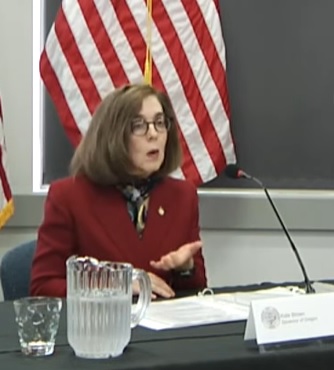





 The future of transit may be waning, at least in the Portland area. Voters rejected a transit tax in the 2020 election, signaling that after several months of COVID-19, they were not in the mood for more taxes and more transit. One would think that the part of loss of ridership that is due to people being unemployed would easily come back once the jobs come back. The part of ridership loss due to fear of COVID-19 might be harder to recover.
The future of transit may be waning, at least in the Portland area. Voters rejected a transit tax in the 2020 election, signaling that after several months of COVID-19, they were not in the mood for more taxes and more transit. One would think that the part of loss of ridership that is due to people being unemployed would easily come back once the jobs come back. The part of ridership loss due to fear of COVID-19 might be harder to recover.
 And let's not forget that crime is a big factor in deterring ridership, and Portland had a long, hard summer of crime. It seems like de-criminalizing everything is the rage these days. HB 4907 prohibiting police officer from conducting or participating in activities intended to determine whether person has paid certain user charges, fees or tolls imposed by mass transit district passed the House but never made it to the Senate in the walkout-shortened 2020 session.
And let's not forget that crime is a big factor in deterring ridership, and Portland had a long, hard summer of crime. It seems like de-criminalizing everything is the rage these days. HB 4907 prohibiting police officer from conducting or participating in activities intended to determine whether person has paid certain user charges, fees or tolls imposed by mass transit district passed the House but never made it to the Senate in the walkout-shortened 2020 session.
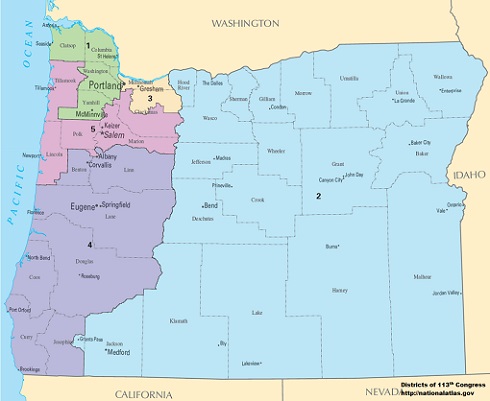




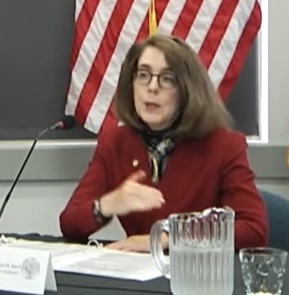

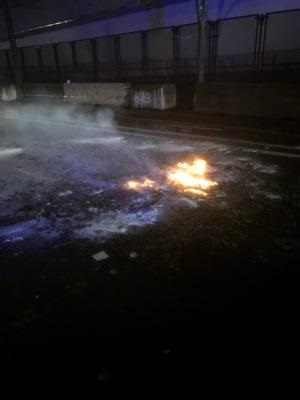

 The Joint Committee on Transparent Policing and Use of Force Reform is looking to beef up the six police reform bills passed in the first Special Session. In addition, some new concepts include requirements for disclosing the identity, disciplinary standards, modify use of deadly physical force and create a data base of use of physical force, bans choke holds and tear-gas, protection for whistleblowers, and disciplinary alternatives.
The Joint Committee on Transparent Policing and Use of Force Reform is looking to beef up the six police reform bills passed in the first Special Session. In addition, some new concepts include requirements for disclosing the identity, disciplinary standards, modify use of deadly physical force and create a data base of use of physical force, bans choke holds and tear-gas, protection for whistleblowers, and disciplinary alternatives.
